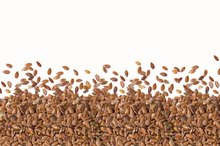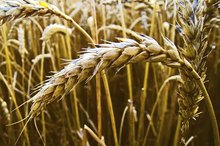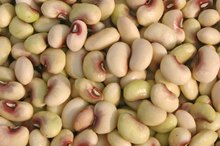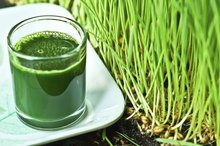What Is the Difference Between Flaxseed & Wheat Germ?
Wheat germ and flaxseed oil appear to have similar tastes, applications, nutritional values and even appearances 2. However, they are distinct; deriving from separate plants and containing different constituents, they are not interchangeable. In fact, there are more differences between the two health foods than there are similarities. Nonetheless, they can be used in the same way in foods, rendering them easily confused.
Wheat Germ
Wheat germ is a kernel at the center of a wheat seed from which a new wheat sprout develops. The most densely nutritious portion of wheat, it has a mildly nutty taste that is easily overwhelmed by other flavors, making it a versatile ingredient. The most common appearance of wheat germ is in small golden kernels, although its also available as a powder, extract and oil. Wheat germ requires refrigeration to prevent rancidity.
- Wheat germ is a kernel at the center of a wheat seed from which a new wheat sprout develops.
- The most common appearance of wheat germ is in small golden kernels, although its also available as a powder, extract and oil.
Flaxseed
Does Flaxseed Contain Soluble or Insoluble Fiber?
Learn More
Flaxseed, or linseed, is a seed of the flax plant. It appears as whole seeds yellowish to reddish-brown in color or as a powder. Flaxseed is also available in fermented form, which is reputably more nutritious than its unfermented version. Flaxseed also yields an oil that is comparable to soybean, pumpkin seed, canola and walnut oil. Similar to wheat germ, flaxseed requires refrigeration.
- Flaxseed, or linseed, is a seed of the flax plant.
- Flaxseed also yields an oil that is comparable to soybean, pumpkin seed, canola and walnut oil.
Wheat Germ Nutrition
Wheat germ is one of three constituents of a wheat seed, the other two being the outer hull and the endosperm. Although the outer hull provides fiber and the endosperm is almost entirely composed of starch, the wheat germ is where wheat harbors all of its nutrition. Accordingly, the wheat germ also contains rather small amounts of starch and fiber. Vitamins and minerals that appear in wheat germ include:
- potassium
- zinc
- folate
- magnesium
- phosphorus
- vitamin S
- thiamin
- riboflavin
- niacin
- Wheat germ is one of three constituents of a wheat seed, the other two being the outer hull and the endosperm.
- Although the outer hull provides fiber and the endosperm is almost entirely composed of starch, the wheat germ is where wheat harbors all of its nutrition.
Flaxseed Nutrition
Differences Between Wheat Germ & Wheatgrass
Learn More
Flaxseed is not dense with nutrients like wheat germ. However, it does contain high amounts of omega-3 and omega-6 fatty acids, which have several health benefits, including raising high-density lipoprotein and lowering low-density lipoprotein cholesterol. Flaxseed also contains both soluble and soluble fiber as well as mucilage, a gummy material that enhances fiber's digestive effects. As a result, flaxseed is often used as a laxative. Other properties of flaxseed include protein and lignans.
- Flaxseed is not dense with nutrients like wheat germ.
- Flaxseed also contains both soluble and soluble fiber as well as mucilage, a gummy material that enhances fiber's digestive effects.
Related Articles
References
- USDA; A Grain of Truth About Fiber Intake
- "Wheat Germ: Biochemical and Nutritional Implications"; Muhammad Umair Arshad and Faqir M. Anjum; 2010
- Schagen SK, Zampeli VA, Makrantonaki E, Zouboulis CC. Discovering the link between nutrition and skin aging. Dermatoendocrinol. 2012;4(3):298-307. doi:10.4161/derm.22876
- National Institutes of Health. Vitamin E: Fact Sheet for Health Professionals. Updated February 28, 2020.
- Keen MA, Hassan I. Vitamin E in dermatology. Indian Dermatol Online J. 2016;7(4):311-5. doi:10.4103/2229-5178.185494
- Food Allergy Research & Education. Wheat Allergy.
- Berkeley Wellness. University of California. Should Anyone Take Vitamin E?. Published January 24, 2014.
Writer Bio
Skyler White is an avid writer and anthropologist who has written for numerous publications. As a writing professional since 2005, White's areas of interests include lifestyle, business, medicine, forensics, animals and green living. She has a Bachelor of Arts in anthropology from San Francisco State University and a Master of Science in forensic science from Pace University.









